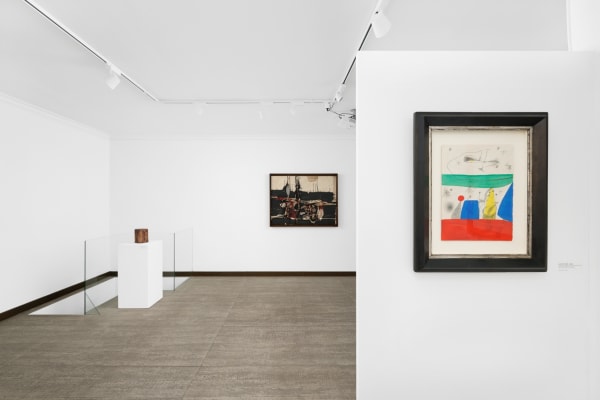Maria Helena Vieira da Silva Lisboa, 1908-Paris, 1992
"And then, it also happens that the painting is well constructed, with a good layout, but that I don't like. Rigour is not enough for me. I need to be able to play hooky. I need freedom, fantasy, impromptu. That is very important. I think that's the best part of me."- Maria Helena Vieira da Silva
Maria Helena Vieira da Silva (Lisbon, 1908 – Paris, 1992) was a renowned Portuguese-French abstract painter. She is celebrated for her distinctive style and contributions to the field of geometric abstraction. Throughout her career, Vieira da Silva became recognized for her intricate compositions, vibrant use of color, and masterful depiction of urban landscapes.
Vieira da Silva was born into an intellectual family, and from an early age, she displayed a keen interest in the arts. Encouraged by her parents, she began her artistic training at the Academy of Fine Arts in Lisbon. In 1928, she moved to Paris to pursue her studies at the prestigious Académie de la Grande Chaumière. There, she came into contact with the avant-garde art movements of the time, such as Cubism and Surrealism, which greatly influenced her artistic development. In the 1930s, Vieira da Silva's work underwent a significant transformation. She started exploring abstraction, developing her unique visual language. During this period, she was deeply inspired by the works of Paul Cézanne and Piet Mondrian, among others. She experimented with various techniques, including collage and the use of multiple perspectives, to depict urban scenes and architectural elements. In 1937, Vieira da Silva participated in her first solo exhibition at the Galerie Jeanne Bucher in Paris, marking the beginning of her successful career as an artist. However, the outbreak of World War II forced her to flee Paris, and she sought refuge in Brazil with her husband, the Hungarian painter Arpad Szenes. During her time in Brazil, she continued to paint and exhibited her work in São Paulo and Rio de Janeiro.
After the war, Vieira da Silva returned to Paris and established herself as one of the leading figures in the School of Paris. She gained international recognition for her captivating compositions, which often depicted fragmented spaces and intricate labyrinthine structures. Her works conveyed a sense of movement, energy, and depth, inviting viewers to explore the complex layers within her paintings.
Vieira da Silva received numerous accolades throughout her career. In 1956, she was awarded the prestigious Carnegie Prize for her outstanding contribution to contemporary art. She continued to exhibit her work extensively in Europe and the United States, solidifying her reputation as a prominent abstract artist. Her paintings can be found in major museums and galleries worldwide, including the Centre Pompidou in Paris and the Museum of Modern Art in New York City. Vieira da Silva's innovative approach to abstraction, combined with her meticulous technique and unique visual language, continues to inspire and influence generations of artists. Her contributions to the field of art and her dedication to pushing artistic boundaries have secured her a lasting place in the annals of modern art history.
-

La radicalité à l'oeuvre
PARIS 6 Jun - 21 Aug 2023Mayoral is delighted to announce its summer group exhibition, showcasing a selection of works by post-war artists who, in their individual ways, embraced a radical approach in their creative processes:...Read more -

Resurgent Light
PARIS 20 Jan - 2 Apr 2022Mayoral presents an exhibition on Juana Francés and Maria Helena Vieira da Silva, two women who both experienced forms of exile and displacement and broke numerous codes for “women-artists”. Curated...Read more
-

Gestures and Geometries: Two Exceptions | Elena Sorokina
Elena Sorokina, curator of " Resurgent Light" by Juana Francés and Maria Helena Vieira da Slva talks about the exhibition January 27, 2022Juana Francés, Maria Helena Vieira da Silva, female artists, exhibition, Mayoral, Resurgent LightRead more -

Maria Helena Vieira da Silva – Juana Francés | Pierre Léglise-Costa
Pierre Léglise-Costa talks about the exhibition "Resurgent Light" at Galeria Mayoral, Paris January 27, 2022Juana Francés, Maria Helena Vieira da Silva, female artists, exhibition, Mayoral, Resurgent LightRead more






